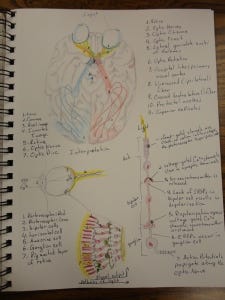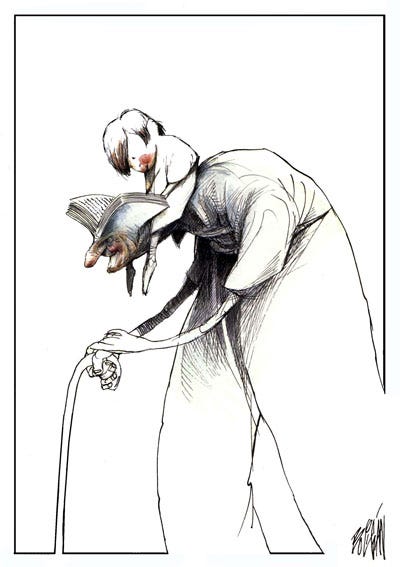Adding Color to Life

Metaphor: In through the eyes, imagination stimulation.
Without metaphor, our language and literature would be pale shadows of themselves. Through the use of metaphor, words and phrases can expand their meanings in memorable ways that illuminate a greater meaning to the reader through a sometimes unconscious understanding of what is truly being said. To the uninitiated, a simple phrase may read like code: ‘the apple doesn’t fall far from the tree,’ seems to say only one thing, however, the fluent reader will quickly and without a conscious thought assign it another meaning as well; that the child resembles the parent. Some metaphor, particularly in the sparse verbiage of a poem, is not so easily discerned, leading to the reader being drawn into a closer study of the metaphor and work of literature it is found in. This conscious contemplation is an awakening of the mind to the true meaning underlying the surface appearance of the text.
This engaging of the whole attention of the reader is the purpose of some layered metaphors, which yields a deeper understanding to those who spend the time in reading, study, and re-reading until the true depth of metaphor is revealed. Why would some choose to cloak their meaning in obscurity? An author may have chosen this in order to discuss a difficult topic, as William Blake in his poem The Garden of Love.
My analysis of the poem “The Garden of Love” by William Blake is that it is a metaphor of the body and interpersonal relationship on a sexual level with others. In the Christian religion the body is said to be the temple of God. In Blake’s poem the chapel being barred by religious strictures is a metaphor for his body being closed off from the delights and pleasures available to that chapel from the garden, or those who were around him, in the reference to play.The Bible has a number of verses referring to the body as the temple of Christ, but most clearly stated in I Corinthians 6:19 “What? know ye not that your body is the temple of the Holy Ghost [which is] in you, which ye have of God, and ye are not your own?” Now, this is, meaning that it was to be kept clean and healthy, but the rigid church structure during the 18th century, where not only the Bible was used for teaching, but the Common Prayer Book had been so tied into social history by more than a hundred years of use at the time of Blake’s birth, had warped the religion of love into something Blake abhorred, and in The Garden of Love he makes a poignant metaphor to decry the loss of sensuality to the strictures of the church.
There are multiple layers of meaning able to be drawn from Blake’s poem, which is an indictment not only of religion, but of the culture that allowed the chains to be drawn tight around them, and which preferred to ponder ghastly graves than flowers, lightness, and love. The use of a floral language, even if not directly referenced, is implicit in his use of the contrast between sweet flowers, and briars. In the presentation image we created for the remediation of a metaphor, the flowers used to convey the sentiments of the poem are weedy, unbeautiful, or ephemeral: that is, not flowers you could pluck and add to a bouquet without them dying very quickly.
Blake himself, in the poem, uses language in a way meant to sway his audience toward him. Who could resist the idea of the idyllic child’s play on the green, romping in the sunshine? Then, from sweet flowers to tombstones, again, the natural draw is to life, joy, and the desires he so vividly describes as bound with briars. No child having grown up in the countryside playing outdoors and picking berries would be able to resist the memory of sweet juices hard-won with a little blood and tears from scratches. Blake, a master of this appeal, makes his audience recoil from a cultural constant, the weekly trip to a church, and perhaps, consider what they went to the church for, and why.
John Donne, in his poem The Flea, provides an excellent example of the illumination research can bring to a metaphor. In this case, when hundreds of years have passed between reader and author, leaving the reader peering through a fog of changing language to be sure of the original meaning, looking at what words have changed, and how they were once used can lead to a fuller understanding of the text. Donne was familiar with the biting insect as a metaphor for closeness. In our antiseptic society, the idea of a flea is disgusting and horrifying to some in a romantic setting. In his time, the suitor in the poem was using a hackneyed pick-up line, as badly received as ‘hey, baby, what’s your sign?’ would be today. The humor of the original intent is restored with this understanding of Donne’s metaphor.
Metaphor can be used to add emotional impact to a story, as in my flash fiction tale A Flash of Rain, where I used the idea of watering a garden in the rain as a metaphor for futility and dementia. The viewpoint character is never fully delineated or described, but the reader is allowed to fully identify with either the caregiver, as many of us face the reality of caring for our aging family; or with the woman watering her garden in the rain, our worst fear, the living death of unknowingness.
A Flash of Rain
Aunt Emma was watering the garden in the rain when I got home. I got out of the car and went to her, my shoes soaking in the mud and water as fast as I stepped into it. Her face was turned down like a wilted flower, but when I lifted her chin, I could feel the slickness of her drool on it.
“Oh,” was all I could say. “Oh, my dear.”
She looked at me with vacant eyes, and we stood there in the wetness, her gone, and my mind flying back over the years to my childhood and the warmth of the sunshine, of her smile as we picked flowers together.
“How did we get here?”
She didn’t answer, but tremulously, she lifted a hand to touch my cheek. I bent my head into her touch, feeling that she was cold.
“Come inside.”
Still no reply, but when I crooked my arm, she slid her little hand into my elbow, and we walked together toward the house. The hose laid forlornly on the muddy ground behind us, as we walked slowly, the core warmth seeping out of me. When we reached the door, I knew that she would never be able to be alone again. From my caretaker, to my care. And I knew my care would be as helpful to her as watering the garden in the rain.
*************
Visual metaphors offer a surprisingly complex depth, often without the use of any words at all. I found this cartoon as I was reading, and it made me, without words, homesick for my grandmother. She has not yet passed beyond, and as she is a writer, I am still able to do what the child in the cartoon is: to read from her thoughts and experiences, and in doing so, to deepen my own understanding of life. Image can convey a metaphor that crosses language barriers; the cartoon below was drawn by an Iranian, intended for an audience the speaks no English, yet I am perfectly able to understand, yearn, and learn from his visual metaphor.

Without metaphor, language becomes a blunt instrument, unable to tease fine emotions from a text with scalpel-like precision, flaying open the heart and mind to allow the reader to fully grasp an author’s intent. Life becomes an open book to the reader fully aware of metaphor in their everyday life, and the writer skilled in its use can convey a meaningful conversation in the sparsest of texts. Being cautious of overuse, where obfuscation can obliterate the true intent of a writer, metaphor in moderation is a powerful tool.




